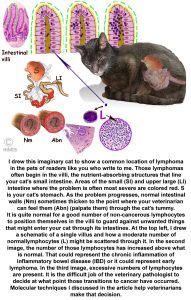
What Is Lymphoma And How Does This Disease Develop?
Lymphoma is a tumor of one type of white blood cell the lymphocyte, that is an important part of your cat’s immune system. The purpose of lymphocytes is to recognize and defend your cat’s body against invaders. As a sentinel and soldiers of your cat’s immune defensive system, lymphocytes need a natural capacity to increase their numbers rapidly when the need arises. But when changes (errors, mutations) occur in their DNA, their increase in number has nothing to do with defending your cat’s body. At that point, the lymphocytes have become a loosely organized cancer. a tumor that has forgotten its original purpose – that loosely organized group of cells is now a lymphoma. Lymphoma is one of the most common types of cancer in cats. Cats appear to suffer from this disease more than any other animal species. (read here) Lymphomas can form in any area of your cat’s body that harbor large numbers of lymphocytes and for a number of different reasons. Those reasons, and the locations the tumor resides appear to have shifted over the last twenty five to thirty years. Today, your cat’s digestive system (its alimentary system) is the most common target of lymphomas. That is most likely because the digestive system and lymph nodes that surround it (the mesenteric lymph nodes) are home to the largest active population of lymphocytes in your cat’s body. It is perhaps also because those lymphocytes are under constant stimulation from the organisms and compounds passing through your cat’s digestive system. They are important policemen of the system – letting required nutrients into the body while recognizing and blocking the passage of interlopers and invaders.
What Are Feline Lymphoma “Demographics”?
The frequency of lymphoma in cats and the characteristics of the tumors differ moderately depending on the area of the World where you live. It is hard to explain why. Perhaps cat genetics and care differ somewhat in different continents and cultures. Perhaps research studies, techniques and interpretation differ by location as well. Whatever the reasons, in North America today, lymphoma is the most common gastrointestinal tumor of cats. It is responsible for about 20-30 % of all feline tumors. Being a Siamese cat, a short haired cat, a male cat or a cat from a cigarette-smoking household appears to slightly increase the chance of this disease occurring. When your cat exceeds 7 years of age its chances of developing lymphoma steadily increase. The median age at which this disease is diagnosed in cats is 13 years. (read here) When it is the cat’s digestive system that is affected, about two-thirds of the time, the lymphomas form in the walls of the cat’s small intestine or/and the lymphoid structures that surround it.
Is The Prevalence Of Lymphoma In Cats Changing?
It appears to be increasing although that could be an illusion.
Over the last 20 years, lymphoma diagnosis in older cats has become more common. That could be because veterinary diagnostic medicine is more sophisticated than it once was. It could also be because other disease like feline leukemia (FLV) are now preventable with good vaccines. It could be that more cats are living solely indoors where accidents are less likely to happen. It could because cats provided better nutrition tend to live longer which give all cancers more time to develop. It could be exposure to unhealthy dietary ingredients and it could be a combination of all or some of these factors. Interesting and concerning, the incidence of lymphomas in humans is increasing as well. (read here)
Although lymph node lymphocytes anywhere in a cat’s body can probably be the origin of lymphomas, the walls of the cat’s intestines are a common site for the problem to begin. As in all mammals, a normal cat’s intestinal walls contain a large number of lymphocytes. They act as sentinels to block the passage of harmful bacteria present in the intestine. (read here) The number of those lymphocytes increase in all forms of chronic intestinal inflammation, including inflammatory bowl disease (IBD) and feline triad disease. Many veterinarians and veterinary pathologists believe that the emergence of intestinal lymphoma is simply the final stage of long term intestinal inflammation. (read here)
If My Cat Develops Lymphoma What Signs Might I See?
In lymphoma’s early stages your cat’s signs and symptoms are often the same as those of cats with the various forms of cholangiohepatitis : weight loss (in about 75% of lymphoma cats), periodic decreases in appetite (~ 65% of lymphoma cats), periodic vomiting (~ 75%) , diarrhea (~ 60%), decreased activity, changes in bowel habits and stool appearance. Early in lymphoma cases these changes tend to be cyclic – good days and bad days. But is some cats, the good and the bad periods last for months. Over time, these cats loose weight (~85% of them). A common misconception early on is that the problem is due to hairballs or food allergies.
Unfortunately, with the set of symptoms I just mentioned, all we know is that something is affecting your cat’s digestive tract. That could be chronic pancreatitis, gall bladder/liver problems, inflammatory bowel disease or lymphoma. But it could be many other things. Tritrichomonas is a common cause of chronic intestinal issues in cats. (read here) But cats with that parasite or other parasite-caused intestinal problem tend to be younger and under environmental stress. When a diagnosis of a giardia infection is made, in my opinion there is always a much more important underlying intestinal health issue that needs to be addressed.
When intestinal lymphoma affects humans (you cannot catch lymphoma from your cat) symptoms are also vague (“atypical”) and the misdiagnosis rate is high. As for physicians, for your veterinarian to diagnose lymphoma with certainty, an intestinal biopsy is always required. And even after an intestinal biopsy, doubts can remain as to whether intestinal inflammation in your cat has progressed to true lymphoma cancer. As I mentioned, what I am describing here is the “slow” form of feline digestive tract (=alimentary tract) lymphoma. The form that is most common in cats. It is the least aggressive form of lymphoma with the slowest rate of progress. It is also referred to as Low Grade Alimentary Lymphoma (LGAL). Read about it in considerably more detail here.
What Tests Might My Veterinarian Run To Diagnose Lymphoma?
Since the symptoms of lymphoma in cats are so non-specific, your veterinarian will do his/her best to rule out other possible causes for a downturn in your cat’s health. If you cat is over 7 or 8 years old, lymphoma as the underlying cause of ill health might already come to mind. In cats of that age, multiple health issues are not uncommon.
A Physical Exam
That starts with your cat’s physical exam and and extensive review of your cat’s history that you provide. Your vet might notice from prior examinations that your cat has lost weight. Or that it had been presented the vet clinic before for similar problems. And if so, what medications were helpful or not helpful at that time. All physical exams should include superficial and abdominal palpation for lumps and bumps. As I mentioned earlier, physical examinations early in lymphoma cases are often normal, and weight loss and an unkempt appearance could have a multitude of causes unrelated to lymphoma. When an abnormal lump, organ shape, or mass is detected on the physical exam, your vet is well along toward a diagnosis. But physical palpation of the abdomens of cats – even in advanced stages of lymphoma – can appear completely normal.
Blood Analysis: CBC / WBC And Blood Chemistry Tests
No blood test that your veterinarian currently has can definitively diagnose lymphoma tumors unless the tumor is of lymphocytes circulating with the entire blood system itself (a leukemia). Leukemias are much less common in cats. However, a complete blood cell count (CBC/ WBCs) sometimes show a mild to moderate anemia (non-regenerative anemia). An even more common finding is a low blood albumin protein level (hypoalbuminema). Low blood albumin protein in lymphomas cases occurs when cats do not eat enough to maintain a normal blood protein level. Also responsible for low albumen are changes in their intestinal lining that limit their ability to absorb proteins (malassimilation). Those same intestinal change can also hinder your cat’s vitamin absorption (eg low B-12 & folate in about a third of the cases) and actually leak protein and other blood elements from the cat’s circulation – the reverse of what it should be. Some of these cats have elevated serum globulin , in others it is low. Blood lymphocyte counts are variable and not diagnostic.
A FeLV And FIV Test
Because your veterinarian knows that cats that are positive for feline leukemia or feline AIDS (FIV) are at a higher risk for lymphoma, your veterinarian will probably want to confirm their negative status. You can read about the test as it is commonly performed here.
X-rays & Ultrasound
Lymphoma cannot be diagnosed for certain using conventional x-rays or ultrasound. However, your veterinarian might suggest them in order to rule out other possible causes for your pet’s poor health. Occasionally, signs of enlarged mesenteric lymph nodes (lymph nodes associated with your cat’s the digestive tract) and/or thickened or dilated loops of intestine will bring lymphoma to mind. A less common location for lymphomas is in the tissue separating your cat’s left and right lungs (the mediastinum). In those cases, the mass of lymphocytes that constitute the lymphoma is more discrete and can be visualized as an increased density in the cat’s chest.
Ultrasound is invaluable to your veterinarian in guiding a needle through the cat’s abdominal wall and into a suspected lesions to withdraw cell samples for analysis (fine needle aspiration, cytology and sample histopathology). When performed periodically, ultrasound is also quite helpful in determining if the medications being administered are shrinking a cat’s lymphoma.
An Endoscopic Exam
Endoscopes are optical apparatuses that allow your veterinarian to peer into your cats digestive tract. They are similar, but smaller in diameter, to the devices use in human endoscopy and colonoscopy . Your veterinarian will be looking for abnormally thickened areas in the intestinal walls, abnormal coloration and, perhaps, ulceration of the intestinal lining. These scopes are designed with a retrieval channel (tube) that allows small snippets of tissue (biopsies) to be harvested whenever the veterinarian encounters a suspicious area. To fully examine the full length of the intestinal tract, common endoscopes must be inserted both down the mouth and up the cat’s anus. Those snippets are then sent to a veterinary pathologist for microscopic examination.
An MRI?
Although it is quite uncommon to use magnetic resonance imaging in typical lymphoma diagnosis, MRI’s can provide important information when lymphomas occur in unusual locations. It is quite uncommon for your local veterinarian to have MRI resources available. But most veterinary teaching hospitals and big national hospital conglomerates like Mars/VCA or Blue Pearl do. The same goes for CAT scans.
What Treatment Options Does My Cat Have?
Lymphoma in cats is not a curable disease. One of the many forms of lymphoma that occurs in humans, Hodgkin lymphoma, is curable about 80% of the times when it is discovered early. But in humans with Hodgkins disease, the lymphocytes involved are a different type of lymphocyte (large CD20+ B and T cells) whereas in cats the lymphocytes involved in digestive tract lymphomas are usually a smaller, slower proliferating, type of lymphocytes, CD3+ lymphocytes cells, with different characteristics.
As I mentioned, the rate at which lymphomas in cats progress is highly variable. When the mutant lymphocytes are less malignant the cases in cats are called the “low grade” or “chronic lymphocytic form”. In those cases, medications that suppress lymphocyte numbers can allow those cats to live for many more years. The most commonly used drug to suppress lymphocyte numbers is oral prednisolone (a glucocorticoid or corticosteroid). Others veterinarians prefer giving an alternative glucocorticoid, dexamethasone. When one or the other drug is no longer sufficient or when side effects are no longer tolerable, some veterinarians add various anti-cancer drugs such as chlorambucil or cyclophosphamide to their treatment plan. (read here) Other veterinary oncology specialist administer a cocktail of cyclophosphamide, vincristine and prednisolone (COP) or a combination of cyclophosphamide, doxorubicin, vincristine and prednisolone (CHOP) to treat cats with the more aggressive large-cell lymphomas. The U. of Wisconsin,s Madison protocol for feline lymphoma involves intermittent (pulsed) use of vincristine, L-Asparaginase, prednisone, cyclophosphamide and doxorubicin. Another group prefers prednisone over prednisolone and throws in methotrexate. All of these anti-cancer drugs must be given by in-clinic periodic injections. The fact that there is so much disagreement as to which chemo drug plan is best attests to the deficiencies of all of them.
My philosophy is that the decision to medicate beyond prednisolone and general nutritional support is one for cat owners to make – not their veterinarians. Just because something can be done doesn’t mean that it should be done or that it is in your cat’s best interest to do it. Colorado State University understood that when they added a philosophy course on bioethics to their vet-student curriculum. A friend of mine, the late Bernard Rollin, believed that many veterinarians promote the treatment of incurable disease far too long. You can ask me for his article on that subject. Some suggest radiation treatment as a “rescue protocol” when medications fail. I personally see that as only a way to extend your cat’s suffering – although I am sure there are other veterinarians and cat owners with different opinions than mine. Another of these so called “rescue” protocols includes a drug called lomustine (aka CCNU) Veterinary oncologist in the USA, UK, and perhaps elsewhere have utilized it in advanced cases of feline lymphoma. The drug has the advantage of being given orally. In a UK study, the drug appeared to them be of benefit for about 61 days. (read here). Regarding that article, I like Bernie, find it sad that cats are allowed that sort of prolong treatment cruelty in a supposedly civilized world.
Is Surgery An Option?
Surgery is an option for a few very isolated, well-demarcated (well defined) lymphomas. They are the ones that are found early and thought to be only present in a single lymph node or a single, well-defined tumor within your cat’s intestine. Surgery is ineffective in treating the much more common diffuse intestinal lymphomas because they usually occur in multiple places in your cat’s digestive tract. When attempted, surgery in those cases tends to actually shorten the cat’s remaining life. However it is quite legitimate to perform exploratory laparotomy surgery in order to obtain biopsy specimens to confirm the lymphoma diagnosis and rule out other causes of your cat’s ill health.
Home Nursing Care
You know that It can be difficult to convince your cat to do what you know is in its best interest. Cats are independent creatures that do not willingly make changes in their basic lifestyle. When your cat is feeling poorly, its relationship with other cats and pets in the household will change. Ill cats seem to do better when you define a special space all their own. Keep your cat in visual or sound contact with the other family members – but give them defined areas to withdraw to when they wish. Pick an area with impervious floors that can be easily washed and sanitized – an area that is airy but not drafty. Keep the temperature in the mid to high seventies. You can set up a card table on which to keep medications and supplies that need no refrigeration. You will need an accessible sink – preferably one not used for food preparation or frequented by other family members.
Add multiple water sources and feed the cat in smaller portions given more frequently than you once did. Consider dog-size water bowls. Provide multiple, larger litter boxes with lower sides and use a brand of dust free litter less likely to cling to the cat. Give your cat help with its grooming. Use the softest slicker brush you can find at a pet megastore. Soiled areas need to be washed gently with warm water, a mild unscented soap, rinsed and dried. Avoid scented products. Carefully clip away the hair surrounding your cat’s anus, have a traveling pet groomer do that or request that it be done on your next scheduled appointment. Cats that produce looser than normal stools often develop enlarged anal sacs that are both uncomfortable and odorous. Have your vet’s nurse show you how to periodically massage them empty (express them). Then gently wash that area. Pat your cat dry with soft paper towels. The sound of hair driers upset cats.
Find ways to administer medications with the least stress to your cat and you. Have your vet’s nurse or groomer trim your cat’s nails shorter and file the ends of each smooth. If your cat resists its medications, consider purchasing a zippered cat bag or roll your cat snugly in a beach towel when you medicate. Tend to any hand cuts or punctures you may receive in the process immediately. Wash your hands thoroughly after giving medications. Many cats resist pilling. Ask your vet’s nurse or a more experienced friend to instruct you on how to best give pills. Ask your veterinarian if the medications required come in a liquid form or one that can be applied topically (a transdermal cream) or compounded by a specialty pharmacy in a variety of flavors and concentrations. Ask if a similar medications exist that can be given less frequently or by injection. Begin a daily diary to record your cat’s weight, body temperature, respiratory rate, medication dose/frequency and your cat’s general condition and symptoms day by day. Include in it your veterinarian’s phone number, the vets off-hour contact number and the number and location of your nearest 24-hour pet emergency clinics.
Cats that are not mobile – particularly those that have lost considerable weight – can develop ulcers (bed sores) on pressure points and continuously damp or licked areas. Treat them as you would treat bedsores in human family members but remember that creams and ointments applied will be licked off and ingested. The areas where your cat rests need to be extra soft, padded and dry. Use washable materials or plan to discarding them frequently. Be cautious about using heating pads and heat lamps designed for people. I have seen as much harm as good caused by heating pads and lamps when unattended. When your cat requires supplemental heat, consider a hot water bottle or a low-temperature, washable heading pad designed specifically for pets. They are safer and easier to sanitize than the ones often sold for human use.
Cats that are feeling poorly are subject to dehydration – both because they drink less and because they loose fluid through diarrhea and vomiting. Cats will go down hill rapidly when dehydrated. Have your veterinarian’s nurse show you the common signs of dehydration to look for (a clay-like inelastic skin, sunken eyes, dry mouth). Cats need supplemental oral or subcutaneously-administered fluids when dehydrated. In advanced cases your cat might need injectable fluids on a regular basis. Ask you veterinarian if you might be taught how to give those fluids at home. Inform your vet of any changes – be they good or worrisome. Talk to your cat frequently. Link up, in person or online, with cat owners dealing with the same or similar problem.
What Is The Best Diet For My Sick Cat?
The best sign that your cat is dealing a well as possible with lymphoma is its ability to maintain a healthy body weight. Cats with lymphoma commonly have poor appetites and become picky eaters. Purchase an accurate table-top digital scale, weigh your cat twice a week and add that data to your medical diary. Over time, you will probably have to tempt your cat with more savory foods that have the odors and mouth-feel that your cat most prefers. There are many commercial prescription diet sold for cats that are reluctant to eat. Although veterinarians and cat owners are constantly drilled by those companies never to suggest that you make your cat’s meals at home, I often find that home prepared meals are accepted better. My golden rule is that a cat that eats anything that maintains its body weigh is better off than a cat that eats a commercially prepared diet that yields poorer results.
Here are some hints: Warming foods make them smell more appetizing. Foods with pungent odors (meats, fish) are likely to be eaten even when commercial cat foods are rejected. One of the greatest blessings you can offer your ailing feline friend is to personally cook savory meals for it. Industrially-produced products are never as desirable. Avoid offering foods that contain preservatives, coloring agents and nitrates. If you have doubts as to its nutritional content, have a company such as Balance IT give you suggestions. Offer multiple small feedings. You can sometimes blend foods into a paste or liquid that cats will lap or lap off of their forelegs when they have no interest in eating them otherwise. Just the fact of cooking these foods in your home fills your house with aromas that stimulate cats to eat. Stroke your cat to encourage it to eat. Organ meats are sometimes accepted when red meats are not. Talk to your cat with encouragement. Consider a trial with Elura® if your cat is still reluctant to eat. If and when the vets suggest a feeding tube, it is time to consider if this is really the kind of procedure you want to subject the cat you love to.
Complications That Might Occur
When lymphoma affects the intestine, blockages sometimes occur. Those need to be deal with promptly by your veterinarian. Their occurrence can sometimes be minimized by altering your cats diet as well as the amount of fiber and water-drawing ingredients (lactulose, polyethylene glycol, etc. ) your cat’s diet contains. When lymphoma affects organs and areas outside of the digestive tract, it will eventually interfere with the proper function of those organs. Those problems are too numerous to list, but your veterinarian will devise strategies to maintain organ function as long as possible. If your cat is receiving chemotherapeutic drugs other than prednisolone or another corticosteroid, the rate of complications is much higher. Those complications are quite similar to the complications that occur when humans receive those same drugs. You will find them in the Wikipedia entries that I link to.
How Will I Know When It Would Be Best To Let Go?
Cats tell their owners that themselves. You know your cat. Do not let someone else tell you that it is time, or it is not time to let go. Do not let anyone lay guilt at your feet for not doing what they suggest. If you have read this far, you know that veterinarians cannot really predict the outcomes of any of the therapies that they suggest.
Specialists, particularly veterinary oncologists, tend to paint a rosier picture than veterinarians that are in general practice regarding their successes. However your veterinarian will probably feel obligated to mention cancer oncology specialists. In some states, they are duty bound by law and veterinary boards to suggest them. However, when questionnaires were given to the owners of cats with lymphoma six month after deciding to treat or euthanize their pets, those that were most comfortable with their decision were the ones that had the most caring and empathetic general practice veterinarians who gave them realistic and complete information on their cats outlook that included cost, number of return visits, adverse treatment reactions and a realistic possible lifespan. ( Ask me for Slatter1996 & Tzannes2008) You can read some of my thoughts on dealing with the grief that will bring you, here.
You are on the Vetspace animal health website
Visiting the products that you see displayed on this website help pay the cost of keeping these articles on the Internet.




